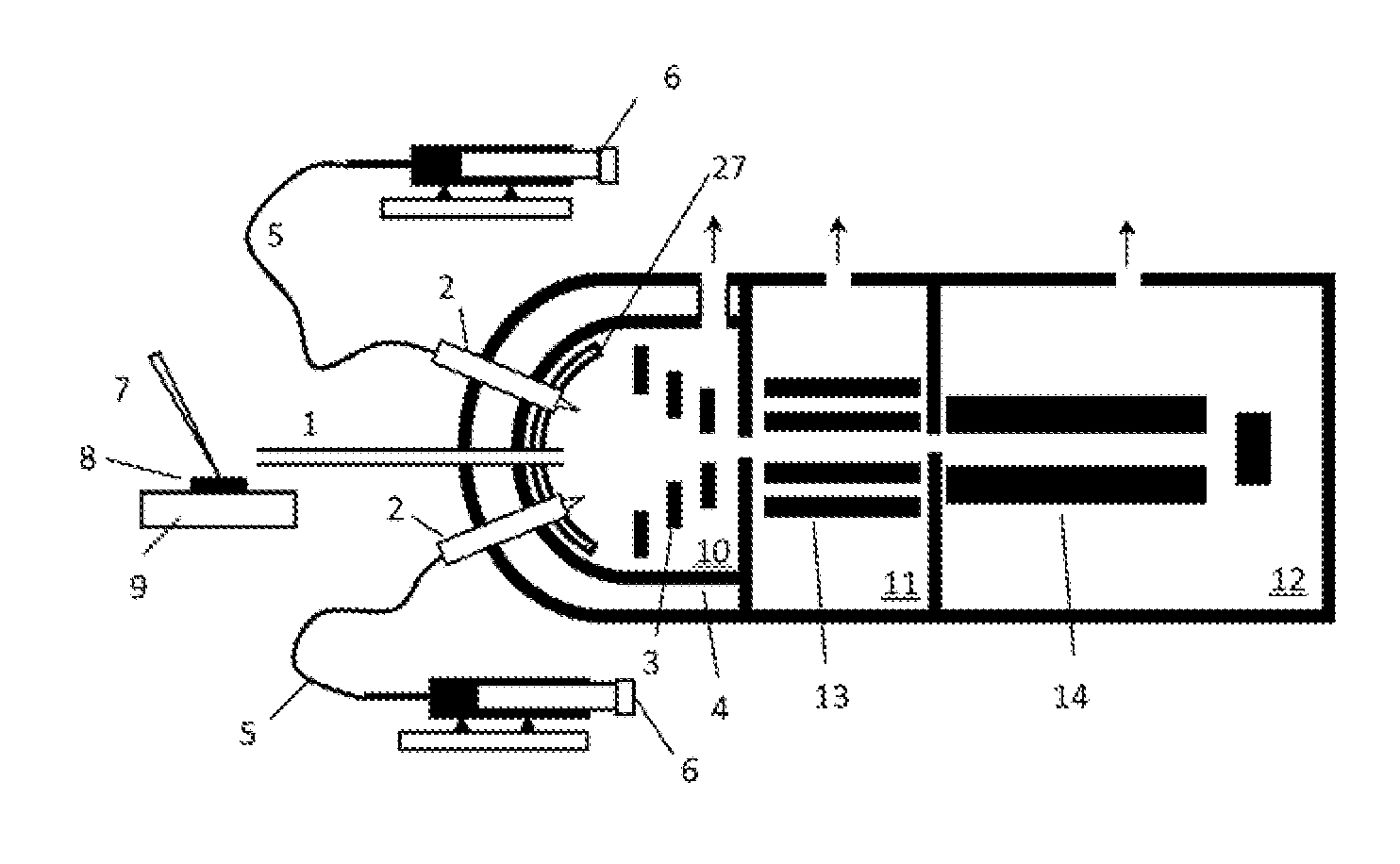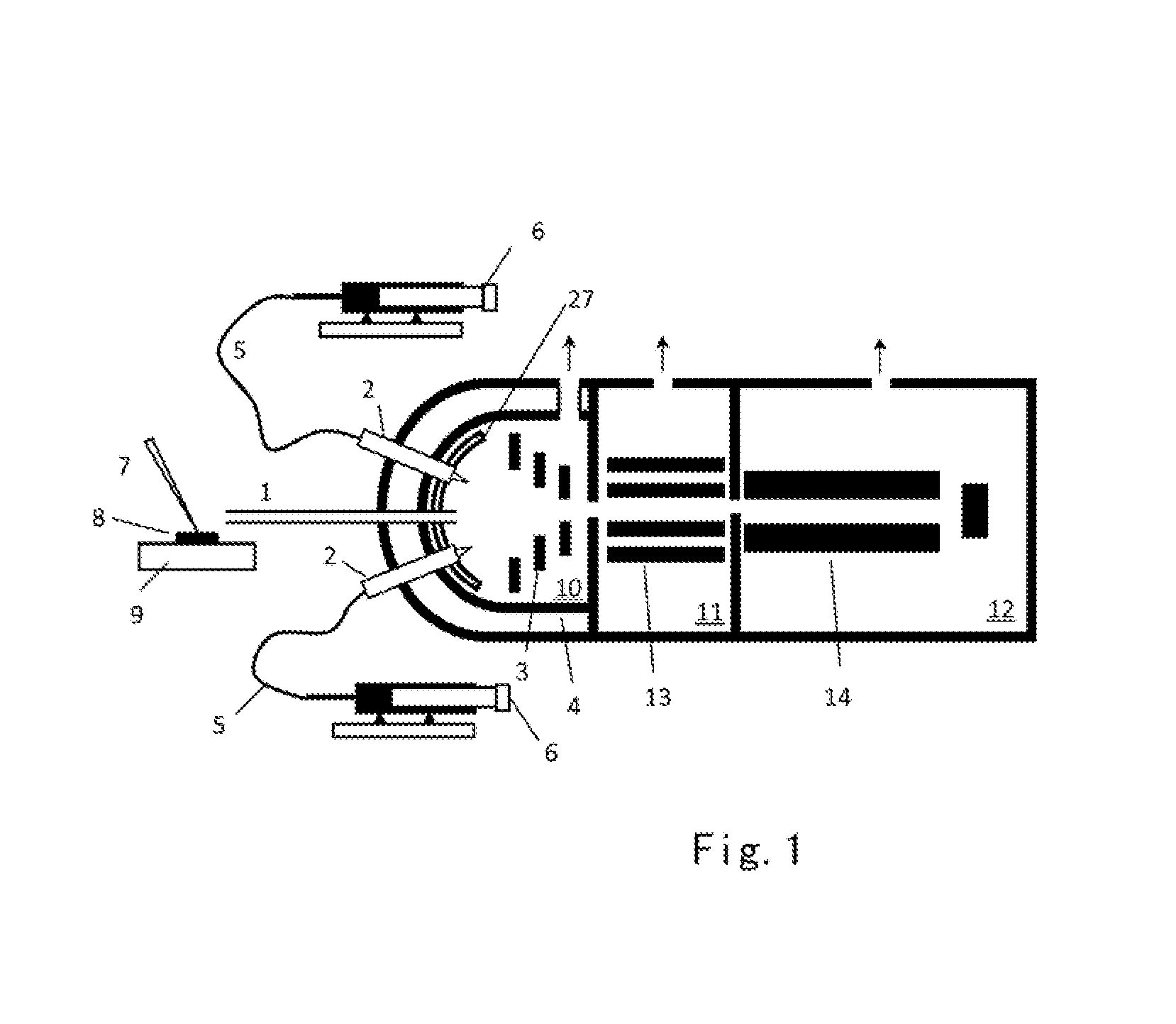Method and apparatus for generating and analyzing ions
a technology of applied in the direction of instruments, particle separator tube details, separation processes, etc., to achieve the effect of high ionization and ion transmission efficiency
- Summary
- Abstract
- Description
- Claims
- Application Information
AI Technical Summary
Benefits of technology
Problems solved by technology
Method used
Image
Examples
first embodiment
[0030]FIG. 1 shows the invention. The purpose of this embodiment is to perform sample desorption in the atmospheric pressure, LP-ESI, and mass analysis of the generated ions. In this embodiment solid sample 8 is placed on a sample substrate 9 located outside the vacuum and is subject to desorption by a beam of laser 7. As an alternative, the desorption process can also be achieved by means such as hot gas or ultrasonic vibration. The desorbed sample molecules are then transferred into a low pressure chamber 10 where the gaseous neutral molecules wound encounter a sprayed mist from the tip of a low pressure ESI probe 2. The solvent used for the LP ESI is provided by the syringe pump 5 and is introduced by the capillary 6. The pressure in the low pressure chamber 10 is preferred to be between 10 to 14000 Pa. The ESI probe 2 used here is preferred to be a nanospray probe where the i.d. of the spray capillary is preferred to be smaller than 10 micron and the flow rate is preferred to be...
third embodiment
[0035]For those analytes with high ionization energy, the photon energy of the vacuum UV may still not be enough. Therefore occasionally the post-ionization of analytes will rely on a charge transfer process with the assistance of dopant ions. As shown in FIG. 3, the dopant gas from the dopant gas container 26 can be brought into the first chamber 10 along with the desorbed analyte molecules and ambient air molecules. The intermediate pressure used in the first chamber 10 of the current invention is advantageous since dopant molecules can still exist in it with a relatively high concentration while keeping a long path length for the VUV photons. Note that the dopant gas from the dopant gas container 26 will enter the first chamber 10 together with the desorbed analyte molecules, the number of the dopant gas molecules is estimated to be counted for half of the gas molecules in the first chamber 10, namely there are about 1013 / cm3 dopant molecules at the pressure of 130 Pa. the curren...
fourth embodiment
[0036]the current invention involves directly coupling the inlet capillary 1 of the first chamber 10 with a gas or liquid source. In this case the desorption source is replaced with a nano-LC 29 where the liquid analytes from within can enter the first chamber 10 through the heated transfer line 30 (FIG. 6). The purpose of using the heated transfer line is to vaporize the LC effluents so that the neutral gas molecules can be obtained in the first chamber 10. For those effluents that are difficult to evaporate, one can also use photo irradiation, ultrasonic vibration, or high flow of hot gas to generate neutral molecules in the ambient air. In this embodiment both ionization means can also be used at the same time. In the mean time, a gas chromatograph or a reaction chamber can be directly connected to the capillary inlet 1 where the exit of the gas inlet can be considered as the sample stage. The only difference between the interface of GC / reaction chamber and that of LC is that the...
PUM
| Property | Measurement | Unit |
|---|---|---|
| pressure | aaaaa | aaaaa |
| pressure | aaaaa | aaaaa |
| pressure | aaaaa | aaaaa |
Abstract
Description
Claims
Application Information
 Login to View More
Login to View More - R&D
- Intellectual Property
- Life Sciences
- Materials
- Tech Scout
- Unparalleled Data Quality
- Higher Quality Content
- 60% Fewer Hallucinations
Browse by: Latest US Patents, China's latest patents, Technical Efficacy Thesaurus, Application Domain, Technology Topic, Popular Technical Reports.
© 2025 PatSnap. All rights reserved.Legal|Privacy policy|Modern Slavery Act Transparency Statement|Sitemap|About US| Contact US: help@patsnap.com



